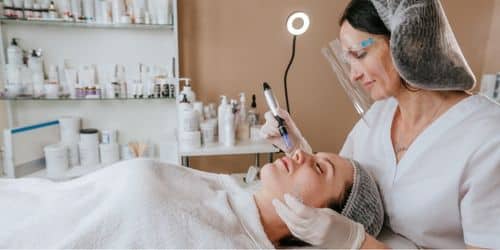If you enjoy interacting with people, working in the beauty industry may provide a range of intriguing career choices. Are you dreaming of becoming an esthetician and do not know how much you might earn once you start your career? Continue reading if you want to find out more about how much estheticians make. In this article, we discussed how much estheticians make in their business, including medical ones. But before that, let’s explain who an Esthetician is.
Who is an Esthetician?
A person who is qualified and licensed to provide skin care advice and treatment is known as an esthetician. They inform the public on all issues pertaining to the well-being and enhancement of the skin. They concentrate on the health and preservation of the skin’s vitality, and they frequently develop customized skin care regimens for their clients. This can entail advising and carrying out expert procedures to guarantee the best possible skin health and look.
What Distinguishes an Esthetician From an Aesthetician?
Both estheticians and aestheticians are skin care experts and professionals. They do have unique qualities and roles, though. Aestheticians frequently perform more clinically oriented work in medical settings. However, aestheticians may perform cosmetic operations in medical spas or other comparable facilities.
Additionally, estheticians and aestheticians frequently work with a variety of customers. Aestheticians typically deal with patients whose skin is affected by medical disorders. However, aestheticians frequently work with people who want to enhance their inherent attractiveness through cosmetic operations.
How Does One Become an Esthetician?
A license and completion of specialized training are prerequisites for becoming an esthetician. The general stages to take in order to become an esthetician are listed below, though the criteria may change according to your province:
#1. Research Regional Specifications and Initiatives
Find out what it takes to become an esthetician in your region. You might need to meet age requirements, training hour requirements, or certificate requirements depending on your jurisdiction. Investigate the programs that are offered in your area based on the standards of your province. Make sure to check whether they provide courses on any treatments you want to specialize in.
#2. Sign up for a Training Course
Enroll in the training course you desire, such as a two-year college course. The majority of programs combine business-related courses, such as those that cover customer service or running a business in esthetics, with courses that address medical issues, like
- Anatomy
- Histology
- infection prevention
- Pathology
- Physiology
The accurate assessment and treatment of skin is a sizable element of esthetician training. This covers ethical standards, safety regulations, and recommended procedures for therapies. Your education may include hands-on instruction to teach you how to:
- Identify skin conditions
- Determine the available treatments.
- Administer therapies
- A lower chance of infection
- Employ equipment
#3. Get your License
It’s crucial to obtain your license after completing your training course. A license from a group like the Canadian Aesthetics Association exhibits your understanding of procedures and demonstrates to both future employers and clients that you possess the relevant credentials. Your license may need to be maintained by taking sporadic training sessions.
#4. Acquire Expertise
Investigate chances to work as an esthetician and obtain experience. To get experience that is relevant, look into apprenticeships. While completing your training, you might also think about working in a spa environment in a non-treatment role, like a receptionist, to gain knowledge of other aspects of the company and what it’s like to work in the beauty sector.
5. Stay Current with Trends
Keep looking for educational options to improve your esthetician abilities. To guarantee that you deliver the best possible care, keep up with the most recent trends and laws. Also, to maintain your position as a leader in your industry, consider obtaining new credentials or learning how to operate new machinery.
What Do Estheticians Get Paid?
A licensed esthetician can expect to earn an annual salary of $30,562 on average. Additionally, many estheticians get suggestions from their customers. But it’s vital to keep in mind that your payments may vary depending on your expertise, your credentials, the treatments you offer, your region, and where you work.
What Distinguishes an Esthetician From a Cosmetologist?
Both cosmetologists and estheticians offer cosmetically oriented rather than medically oriented beauty services. They might offer several therapy alternatives, nevertheless. For instance, cosmetologists may offer some cosmetic and skin care services, but they may also offer hairstyle options including hair cutting and hair coloring. However, skin care procedures are the main area of attention for estheticians.
Additionally, the working conditions for estheticians and cosmetologists vary frequently. In salons, cosmetologists frequently work. However, most estheticians operate in medical spas or other settings that are akin to them.
How Much Do Aestheticians Make a Year?
Most likely, if you’re thinking about a career in esthetics, you’ve been curious about how much estheticians make annually. In reality, an employee’s pay is dependent on a number of factors. These include their years of experience, their place of employment, and their specialization status.
What Do Estheticians Make Per Year?
The average esthetician pay in the United States is $31,290 per year, according to the most available data. The last 25% of estheticians earn around $23,210 a year, while the top 25% make about $44,580, according to data on esthetician salaries. As a certified esthetician, you can expect to earn an annual starting salary of between $18,000 and $20,000 in most cases.
What Factors into the Pay of an Esthetician?
An aesthetician’s salary is based on their experience, the place they work, and the pay they receive. Aestheticians frequently own multiple upscale salons that serve wealthy clients, allowing them to pay their employees better wages than in rural salons. The tips left by clients may also result in increases in estheticians’ pay.
Your income will also depend on whether you choose to work for a company, as an independent contractor, or as a “booth renter.” Dermatologists who work for themselves can earn an average of $52,100 a year, although this varies on how many regular clients they have. Some salons offer a commission structure where employees are compensated for upselling clients on retail items, securing their next appointment before they leave, or selling premium services. Once they have established a good reputation and a profitable business, independent estheticians may make over $100,000 annually.
What Are the Salaries for Estheticians in the Medical Field?
In comparison to their medical counterparts, how much do estheticians make? Medical estheticians make more money than those who work in spas and salons. A medical esthetician makes an average national salary of $47,882, per data released in September 2020. The lowest paid paramedical estheticians earn at least $43,240 a year, while those whose skills are in high demand can expect to make over $55,000.
Who Makes the Most Money as an Artist?
The highest income is earned by independent estheticians, who typically earn between $50,000 and $74,000 annually. That is, after a freelance esthetician establishes a solid reputation or after they launch their own prosperous salon. The location of their firm has a significant impact on how much money they can make as well.
A multi-service esthetician who specializes in eyelash extensions and waxing can earn up to $50,000 annually. The average pay for these workers in the skin care business was $31,290, but the highest 10% of estheticians made $59,790 annually.
On average, medical estheticians earn more than spa estheticians. For instance, the average salary of a medical esthetician with over 20 years of experience is $57,000 annually, while the average salary of a spa esthetician with the same number of years of experience is $35,000 annually.
States with the highest wages for estheticians:
- An average year in Colorado costs $54,810.
- An average year in Washington costs $54,770.
- Hawaii’s annual average income is $53,010.
- Wyoming’s annual average income is $52,490
- Massachusetts’s yearly average salary is $50,440.
How Much Do Medical Estheticians Make?
Many of the same duties are carried out by medical estheticians, or “paramedical” estheticians. These experts typically have additional training to perform specialized treatments and operate in clinical settings.
Can I Obtain a Medical Esthetics License?
Although a general esthetician’s license is required to practice, there are presently no specific licenses available for medical estheticians. The most common path to becoming a medical esthetician entails earning a basic esthetics license and pursuing extra education and certifications in specialty areas, such as chemical peels and microblading. When choosing your career route, verify with your licensing board because many of the specific treatments provided by medical estheticians may not require certification in all states.
Medical Estheticians’ Coursework and Prospective Certifications
Your introduction to diverse skin care, cleanliness, face massage, makeup, and sanitation themes comes from aesthetics training programs. You must speak with your licensing board to find out about precise requirements because each state establishes its own standards.
Despite the fact that medical estheticians are unable to undertake medical procedures, many curricula include instruction in these areas. Courses for medical esthetician training may cover:
#1. Permanent Makeovers
Permanent or semi-permanent pigments are used during this process to apply eyeliner, eyebrow filler, lip color, and other types of cosmetics. This includes the expanding field of microblading often.
#2. Skincare for Both Before and After Surgery
Medical estheticians typically offer cleansing techniques and guidance on how to maintain clean, healthy skin for those who suffer from burns, abrasions, or other sorts of skin injury.
#3. Manual Lymphatic Drainage (MLD)
MLD is used to promote circulation, boost blood flow, and evacuate lymph nodes. MLD therapies are provided to lymphedema patients by medical estheticians.
#4. Advanced Hair Removal
This method, created for those who want to permanently remove hair from specific areas of their bodies, prevents follicle growth using lasers and powerful pulsed light. Medical estheticians may work alongside doctors and laser technicians rather than directly operating the lasers because these procedures are frequently seen as medical rather than cosmetic.
In the US, a medical esthetician has an average salary of $50,405. A medical esthetician’s bonus is typical $3,307, or 7% of their pay, and 100% of those surveyed said they get one every year. San Francisco has the highest average total salary for medical estheticians at $74,297, which is 47% higher than the national average.
Salary Ranges for Medical Estheticians
Medical estheticians make an average salary of $43,582 in the US, with wages ranging from $10,007 to $239,761. Medical estheticians make an average salary of $43,582 to $108,945, with the top 86% earning $239,761.
How Much Tax Will a Medical Esthetician Have to Pay?
In 2018, the average federal tax rate for a single filer in this tax bracket is predicted to be 22%. Medical Estheticians might anticipate taking home $43,376 per year after paying a federal tax rate of 22%, with each paycheck equaling about $1,807*.
Careers as a Medical Esthetician
Here are careers you can look into as a medical esthetician:
#1. Cosmetic Medical Esthetician
These medical estheticians frequently assist individuals who need aid with their appearance following illness or trauma in hospital or rehabilitation settings. They might provide solutions for those with facial deformities, assist chemotherapy patients in finding acceptable wigs, or instruct burn sufferers on how to care for fragile skin.
#2. Esthetician at a Medical Spa
When you work in these environments, you can help your customers feel more confident and stay healthier. Chemical peels, color correction, sun damage repair, tattoo removal, and varicose vein cauterization are just a few of the usual duties.
#3. Inspector for Medical Estheticians in Training
After a while of providing direct client services, you might desire to change your focus. As a training inspector, you’ll visit medical spas, rehab centers, and other places where medical estheticians work to make sure all rules are strictly adhered to.
Finally, knowing some of these distinctions between a medical esthetician and an esthetician might help you choose the best training and career route for you.
How Much Do Estheticians Make With Their Own Business?
Self-employed estheticians can make an average of $52,100 a year, but this depends on having a good relationship with customers.
Can Estheticians Own Their Own Business?
You can’t lawfully run your business if you don’t have a license. You’ll initially require one. Additionally, you’ll need all of the skin-care supplies that most individuals buy when they visit an esthetician.
How Can Estheticians Establish a Business?
The following are ways to start up your own esthetician business:
- Training that is based on a particular therapy.
- To practice cosmetology, you need a license.
- Filling out the paperwork and registering your business
- Having professional insurance is crucial.
- The financial parts of a business are planned using a type of paper called a business financial plan.
- The reputation of your business.
- Create a thorough marketing strategy.
- An appropriate site.
How Do Estheticians Build a Profitable Business?
- Try your best to build a website.
- Study social media to become an expert.
- On Facebook, there are groups for estheticians that you may join.
- Spend some time looking after your finances.
- Give your book’s development high priority.
- Rebook consumers once they go.
What Kind of Business Do Estheticians Do?
For those who are unaware, esthetics is a part of the skincare industry that focuses on giving clients a variety of beauty products and services in order to help them look and feel their best.
Are Estheticians Allowed to Own Their Business?
You have complete control over your spa or salon as the owner. Along with other spa services, you might want to think about growing your company to offer esthetician services. Clients have access to a variety of options in addition to waxing services, massages, body wraps, and other body treatments.
How Can Estheticians Run a Successful Business?
Estheticians can run a successful business through the following steps:
- By making a profile, you may display your work.
- Develop connections inside the cosmetics sector.
- Building trust can be facilitated by positive online reviews.
- Create and implement innovative campaigns.
- Do not forget to thank your customers.
- By concentrating on client retention, maintaining client loyalty
- An excellent choice is StyleSeat.
How Much Money Do Estheticians Require to Begin a Business?
The structure below shows how much estheticians require to begin an esthetician business:
| Cost | Min Startup Costs | Max Startup Costs |
| Small Business Insurance | $500 | $2,000 |
| Permit and License Fees | $50 | $700 |
| Set up business: LLC & Corporations | $50 | $500 |
What Do Estheticians Do?
Estheticians try to make your skin look better and feel better. They talk about the client’s skin care problems, routine, desired results, and any conditions they may have. On the basis of these discussions, estheticians could suggest or carry out treatments. An esthetician typically performs the following duties:
- treating skin issues including wrinkles, dermatitis, or acne
- supplying suggestions for enhancing the look and wellness of the skin
- examining the skin to identify any problems
- recommending effective remedies for problems
- advising clients on skin-care practices
- creating customized treatment plans
- fostering a relationship with customers to earn their trust
- understanding the various skin types
It’s vital to keep in mind that an esthetician’s duties may change depending on where they work. For instance, some estheticians might additionally make product sales to customers. Other estheticians, particularly those who may run their own medical spas, could help with administrative tasks including setting up client appointments, taking phone calls, or liaising with and welcoming visitors.
What Treatments Do Estheticians Offer?
Estheticians offer a wide range of treatments, however, others opt to focus on a single type of care. However, a few instances of remedies they might offer are as follows:
- Waxing facials
- Skin firming
- Skin resurfacing
- Hair removal using lasers
- Body wrapping
- Application of makeup.
- Microdermabrasion
- Using laser skin resurfacing
- Extraction and exfoliation procedures.
- Chemical peels
Estheticians work with a variety of tools and supplies. It’s critical that they always take safety precautions. Wearing protective gear, informing clients of the hazards of therapy, giving clients safety gear, and only utilizing equipment in accordance with manufacturer instructions are some examples of this. Estheticians are also required to abide by rules, such as only treating patients who are a specific age.
It’s crucial to keep in mind that estheticians are not medical practitioners. They don’t formally diagnose skin disorders or issue prescriptions for skin-care products. Nevertheless, estheticians could advise their patients to consult a dermatologist, aesthetician, or another expert for advice.
Esthetic Skills
A combination of both hard and soft skills is necessary to become an esthetician. Hard skills are those that are directly relevant to the work that you master, while soft skills are those that are directly related to your personality and social interactions. Aside from knowing how to use skincare and beauty products, an aesthetician needs to possess a number of other abilities. Among these abilities are:
#1. Communication Skills
Building relationships with your clients and making them feel at ease with you are both made possible through effective communication. These assist you in providing them with crucial information about their available therapy alternatives.
#2. Active Listening Skills
Being an attentive listener and a good information processor are both considered to be active listening qualities. This is crucial so that you can comprehend the objectives of your clients, deal with their issues, and offer them the most suitable solutions.
#3. Personality Skills
You may communicate with your clients and win their trust by using interpersonal skills. These abilities also reveal how you deal with your own emotions and how open you are to other people’s feelings.
#4. Being Able to Multitask
Because estheticians frequently have to visit numerous clients at once or administer several treatments at once, multitasking skills are essential. It’s crucial to be able to multitask without sacrificing patient safety or treatment quality.
#5. Observation of Details
Because estheticians frequently conduct delicate work, attention to detail is crucial. When using equipment, making product recommendations, and adhering to client requests, attention to detail is crucial.
A worry for estheticians may also be their physical fitness. It’s crucial to be able to stand for extended periods of time because aestheticians frequently work on their feet. You must also be relaxed and capable of using various pieces of equipment safely.
Why is a Good Esthetician Necessary?
A professional esthetician should be knowledgeable about skincare and eager to inform their clients about the newest procedures and products. To effectively communicate with patients and apply the appropriate treatment based on their needs, they must be aware of the procedures and materials involved in skin care.
An Esthetician Works with Whom?
In medi-spas, day spas, and other salons, many estheticians collaborate with dermatologists and other medical specialists.
Where Do They Work?
Estheticians can be located in many locations! This profession is frequently praised for its incredible flexibility and potential. Here are a few scenarios in which you might encounter an esthetician:
- Spas
- Salons
- Freelancing
- Movie and TV sets
- Feature Film Sets
- “Med Spas”
- Cruise vessels
- Resorts
What Motivates You to Become an Esthetician?
Consider the following inquiries if you’re not sure if esthetics is something you’re interested in:
- Love collaborating with others?
- Do you like the arts?
- Are you a fan of science?
- Do you want to do manual labor?
- Are you self-reliant and able to maintain good organization?
- Do you desire a flexible future?
If you answered “yes” to any of them, esthetics might be the perfect career choice for you! You might wish to consider a career in esthetics for a variety of reasons. By assisting others in developing their confidence or by working in TV, film, or editorial settings, this career can provide you with the chance to have an impact on people all around the world.
What’s the Difference between Aesthetician and Esthetician?
Both estheticians and aestheticians are skin care experts and professionals. They do have unique qualities and roles, though. Aestheticians frequently perform more clinically oriented work in medical settings. However, aestheticians may perform cosmetic operations in medical spas or other comparable facilities.
What’s the Difference between Aesthetician and Esthetician?
The highest income is earned by independent estheticians, who typically earn between $50,000 and $74,000 annually. That is, after a freelance esthetician establishes a solid reputation or after they launch their own prosperous salon.
What Makes a Good Aesthetician?
A person who is qualified and licensed to provide skin care advice and treatment is known as an esthetician. They inform the public on all issues pertaining to the well-being and enhancement of the skin. They concentrate on the health and preservation of the skin’s vitality, and they frequently develop customized skin care regimens for their clients.
Related Article
- How Much Do Braces Cost A Month With Or Without Insurance (Detailed Guide)
- DO I NEED A BUSINESS LICENSE? :The Need to Get a Business License
- How to get a business license in Texas: Step-by-Step Guide
- TEAM MANAGEMENT TOOLS: All You Need To Know, Types, and Free Team Management Tools
- Yard Management System
- LETTER OF SUPPORT: How To Write A Letter Of Support
- PRODUCT MANAGER VS PROJECT MANAGER: Job Description Differences
- IDENTITY & ACCESS MANAGEMENT TOOLS: Definitions, Best and Free Identity & Access Tools






